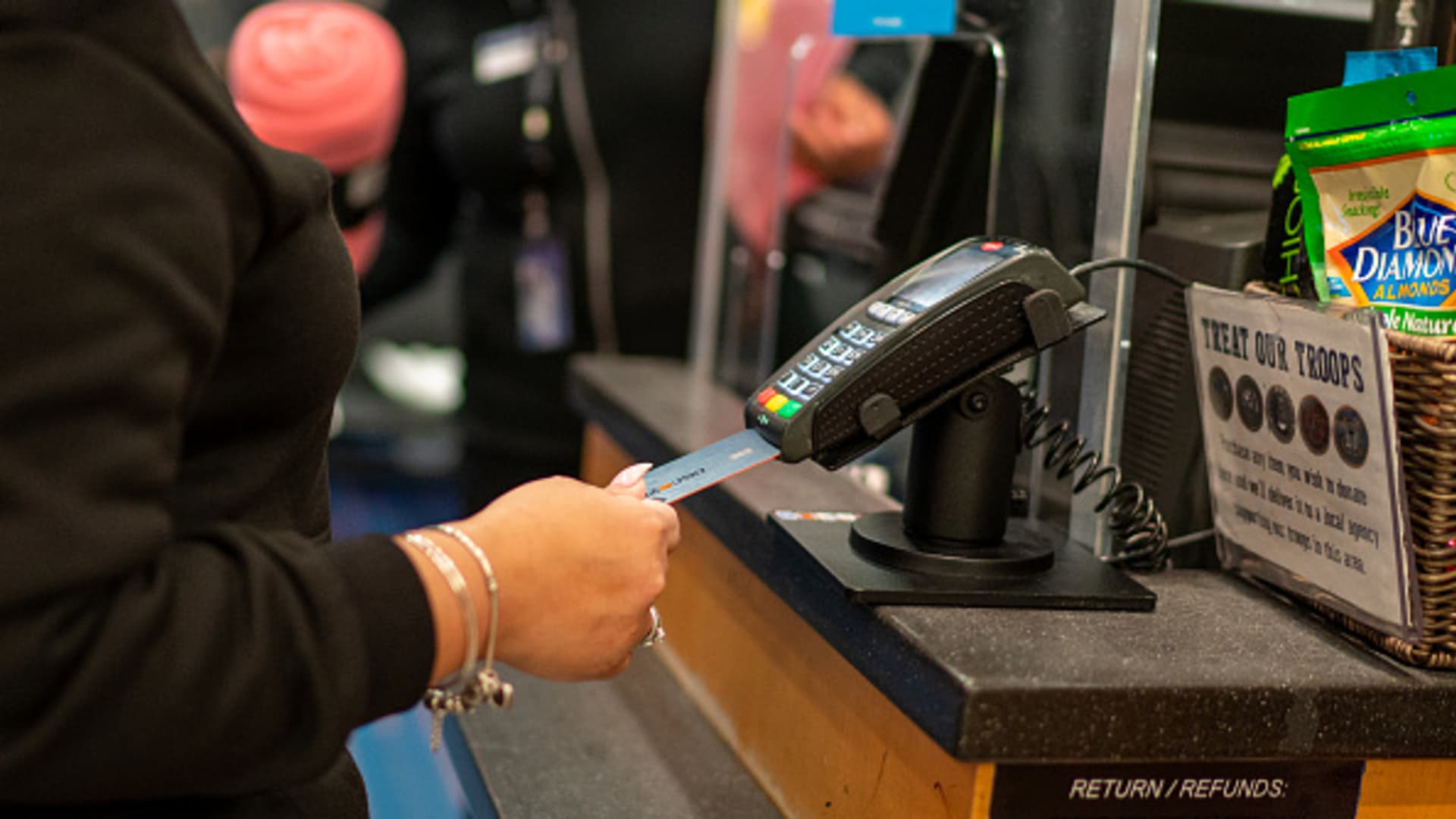
A customer uses a credit card to pay for items January 28, 2022 at a retail shop in New York City.
Robert Nickelsberg | Getty Images
Department stores like Macy’s and Kohl’s have long used store-branded credit cards to drive purchases and get a cut of cash.
Starting this spring, though, those cards will become less lucrative. Late fees for customers will be capped at $8, down from an industry average of around $32, under a new rule from the Consumer Financial Protection Bureau. The change faces legal challenges, but is scheduled to take effect on May 14.
The new rule will benefit customers with overdue balances, but will take a bite out of retailers’ highly profitable business of making money from customers’ credit card swipes and the interest or late fees that get tacked onto their unpaid balances.
Specialty retailers with store cards, such as Gap, will feel the pinch, but it’ll be the most significant at department stores since their revenue is already under pressure, according to Jane Hali, CEO and retail analyst at equity research firm Jane Hali & Associates.
“We are talking about an area of weakness, so any cut in revenue is going to be more important to them than another area of retail,” she said.
For fiscal year 2023, credit card revenue totaled $619 million for Macy’s and approximately $475 million for Nordstrom.
Kohl’s reported $924 million in “other” revenue in 2023, a broader category that includes unused gift cards and third-party advertising on its website, though Fitch Ratings estimates the majority of that revenue category is from credit cards.
The three companies do not break out how much of total credit card revenue comes from late fees.
Value add
Store-branded credit cards are a clear boon for retailers: They encourage purchases and come with virtually no overhead, said David Silverman, a retail analyst at Fitch Ratings.
They’re typically issued through financial services companies and banks, such as Synchrony Financial, TD Bank or Capital One. And they often come with extra perks for shoppers, such as additional discounts or rewards for repeat purchases.
For retailers, the branded cards provide insights into customer behavior, since they track purchases, and can amount to a perpetual advertisement, right in customers’ wallets, Silverman said.
“If I’m constantly using my Macy’s card or my Home Depot card or whatever it is, that brand is even more so part of my daily life,” he said.
Even before the CFPB ruling, retailers’ credit cards faced challenges.
Shoppers, particularly those who younger, are paying in new ways like buy now, pay later, which allows a customer to pay back a purchase in installments. Use of buy now, pay later with online purchases between January and March totaled $19.2 billion, an increase of 12.3%from the year-ago period, according to Adobe Analytics, which analyzes online transactions across retail sites.
Some customers are opting for credit cards that offer experience-based perks, such as access to airport lounges or early purchases of high-demand concert tickets.
Plus, in a higher interest rate environment, getting customers to sign up for store cards or use them may be a trickier proposition. For retailer-issued credit cards, interest rates — also called APRs, or annual percentage rates — were about 29.33% on average as of early April, according Bankrate. That compares to an average of 20.75% for all U.S. credit cards.
All of that adds up to dwindling credit card revenue for retailers, who can now expect to see it shrink even further.
Shrinking segment
For all the millions brought in by private label cards, they drive a small portion of retailers’ net sales. The retailers’ credit cards accounted for nearly 3% of Macy’s net sales and a little over 3% of Nordstrom’s net sales in the most recent fiscal year.
Kohl’s, Macy’s and Target all reported year-over-year declines in credit card revenue in the most recent fiscal year — a reflection of reduced discretionary spending and normalizing credit patterns, according to the companies.
Target’s credit card revenue fell to $667 million last year, down from $734 million in the prior fiscal year. Chief Operating Officer Michael Fiddelke said at an investor meeting in March that the discounter has seen softer spending on credit cards, but has been able to make it up with growth of its advertising business, Roundel.
The big-box retailer recently relaunched its loyalty program as a three-tiered offering that includes a free tier, a paid annual membership and a credit card that’s now called Target Circle Card.
Macy’s, too, has dealt with falling credit card revenue. The segment’s $619 million during the most recent fiscal year was a decline of about 28%. And Macy’s said it expects that to tumble even further to between $475 million and $490 million for this fiscal year as net sales fall.
That outlook doesn’t take into account the credit card late fee ruling.
Adrian Mitchell, chief operating officer and chief financial officer, told investors on the company’s earnings call that Macy’s is working with Citi, its financial partner, to try to offset the late fee ruling. It’s also looking for strategies to increase customers’ use of Macy’s and Bloomingdale’s credit cards, he said.
Nordstrom, for its part, has reported year-over-year gains in credit card revenue for each of the past three years, though its haul is smaller than that of Kohl’s, Macy’s and Target. It downplayed the CFPB change, saying the average credit quality of its portfolio tends to be higher than other retailers, meaning it relies less on late fees.
Gap does not disclose credit card revenue, but its Chief Financial Officer, Katrina O’Connell, said on an earnings call that losses from late fees will be “largely offset in 2024 by other levers within our credit card program.” The company declined to share specifics about those offsets.
Some card issuers, such as Synchrony, have said they will make changes in the coming months, such as increasing APRs, to try to blunt the federal rule’s effect. Synchrony is a major issuer of store cards, including the cards for Sam’s Club and Lowe’s.
Offsetting losses
At Kohl’s, it’s a bit of a different story.
Kohl’s customers typically have lower household incomes than those of other retailers, such as Nordstrom, which makes them more likely to miss a payment and be subject to a late fee, said Lorraine Hutchinson, a research analyst at Bank of America.
And, the off-mall department store retailer Kohl’s is chasing a turnaround under CEO Tom Kingsbury, the former chief of off-price chain Burlington, and is leaning in part on co-branded cards to pull it off.
To offset losses, Kohl’s has been working to get customers to switch from store-branded credit cards, which can only be used in its stores and on its website, to co-branded Capital One cards that can be used to pay for other purchases, too.
In an interview with CNBC in mid-March, Kingsbury said the company had previously planned to introduce the co-branded cards, but accelerated its plans because of the impending CFPB late fee cap.
Co-branded cards “will help offset any late fee changes that we have,” he said.
Kingsbury said as of March that Kohl’s has converted nearly 700,000 private label cardholders. It plans to convert about 5 million more later this year, covering more than a quarter of its 20 million active cardholders.
He also underscored why Kohl’s — and other retailers — want to be in the credit card business.
On average, Kohl’s credit customers spend six times more per year that shoppers who don’t belong to its loyalty program, Kingsbury said. Incremental credit revenue from the co-branded card is expected to grow to between $250 million and $300 million annually by 2025, he said.
— CNBC’s Gabrielle Fonrouge contributed to this report.







